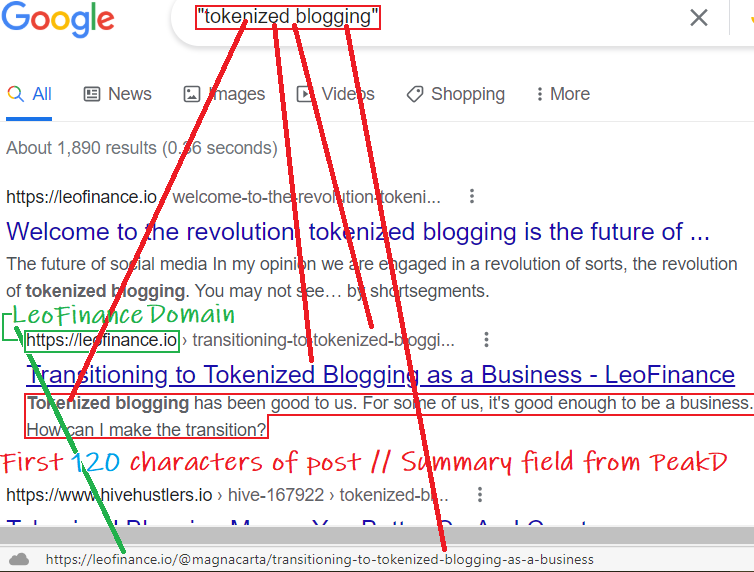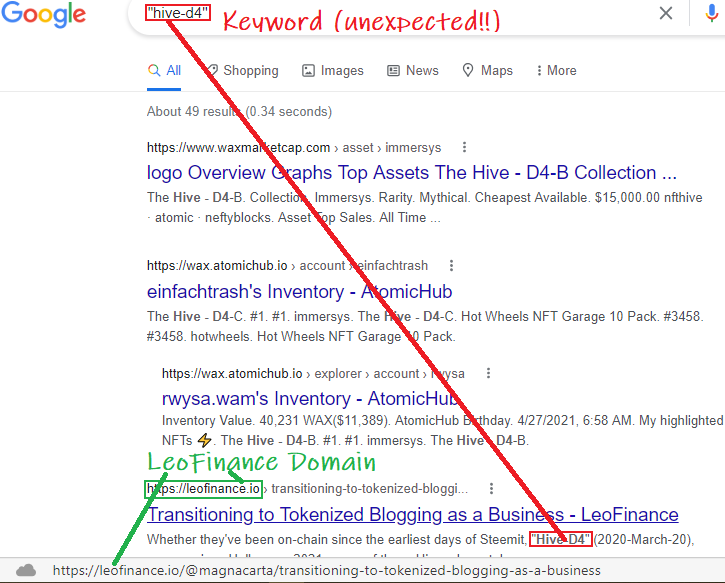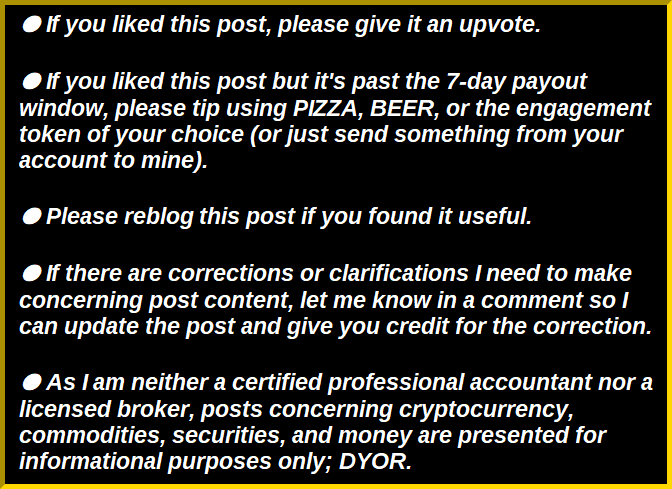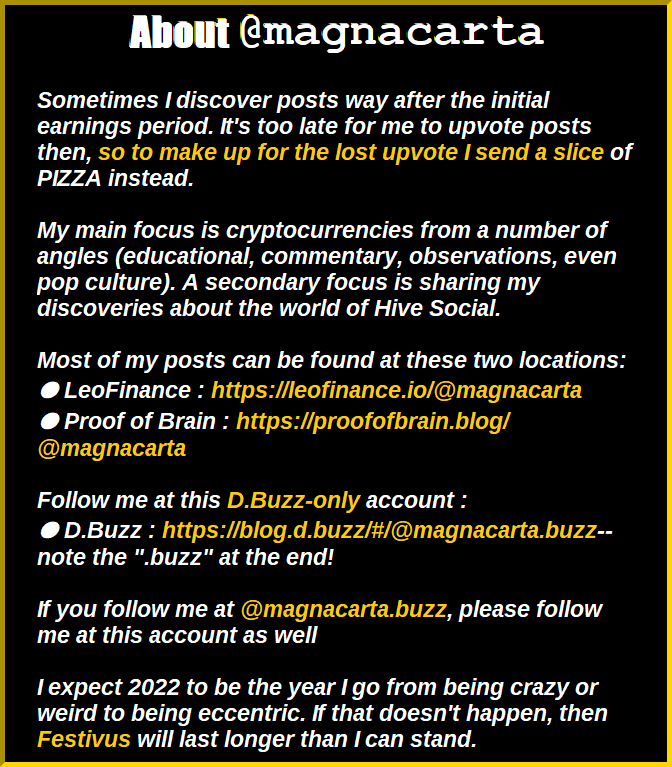SEO Impact on "Transitioning to Tokenized Blogging as a Business"

Already SEO had an impact on my recent post. 2 keywords ranked high on Page 1. What else happened on the SEO side?
Original Cover Image by @magnacarta
We can't control how a certain search engine behaves when its search spiders reach our content. The best we can do it give our content a fighting chance to do as best as it can when this search engine operates fairly. This is one example where the expression "Don't hate the player, hate the game" applies: SEO (Search Engine Optimization).
TL;DR -- General Outline
- How Google Reacted To SEO Used by "Transitioning to Tokenized Blogging as a Business"
- It Picked up the
leofinance.ioDomain as Intended - It Picked up the Intended Keyword "tokenized bloging"
- It Picked up the First 120 Characters of the Post as Intended
- How PeakD Handles the First 120 Characters
- How LeoFinance Handles the First 120 Characters (It Doesn't)
- Giving the Search Engine User a Reason To Click Through
- What Would Have Been the Real First Paragraph
- It Picked up the Accidental Keyword "hive-d4"
- Bonus SEO Benefits for Us
- It Picked up the
- Just My Two Sats
How Google Reacted To SEO Used by "Transitioning to Tokenized Blogging as a Business"

Click the image for full-size view
It Picked up the leofinance.io Domain as Intended
On 2022-May-9 I published a post titled "Transitioning to Tokenized Blogging as a Business" using the LeoFinance front-end. I mention this detail because we're trying to increase organic search engine traffic to the leofinance.io domain, and the front-end used tells Google that content from "this" domain is to be considered official (or, in SEO terms, "canonical") when it finds other copies of the post.
This is one reason that detail is stressed a lot at LeoFinance. Increased organic search traffic from Google aids in adding value to LeoFinance by giving it increased ad revenue. The more times Google finds the leofinance.io domain, the higher the domain itself ranks in overall search statistics, and the better chance content from LeoFinance ranks higher than if it was tagged 3rd in a series of 5 token tags.
As shown by the above image, this is exactly what happened. The link not only appears on the page itself above the search entry, it is also included within the link to the post as shown in the web browser's status line.
With my post emphasizing leofinance.io as the canonical domain, it also helps Google add more weight to other posts published from this domain. This helps explain why the top 2 posts for the keyword "tokenized blogging" originate from LeoFinance.
It Picked up the Intended Keyword "tokenized bloging"
The keyword "tokenized blogging" appears throughout LeoFinance, and it's even found on pages throughout Cub Finance and PolyCub. This is why I chose it to be part of my post's H1 header.
Although the URL for the post can be different from the text in the H1 header, in this case the URL includes the keyword. This allows Google to present the keyword in its bread crumb trail.
Besides including it in the H1 header, I made sure it was within the most precious real estate any web page can have: the first 120 characters of the post. Although the keyword is sprinkled throughout the post where it made sense to include the term, including it in these locations at a minimum helped give the post a better shot at a higher ranking.
By including this intended keyword in these strategic locations (which any of us can do), we give our content a fighting chance to rank as high as possible on the SERP (Search Engine Results Page).
As shown by the above image, the keyword "tokenized blogging" appears in 3 locations on the SERP plus in the URL as shown in the web browser's status line. This is what we want to see when any search engine finds our content.
Accordig to Google, about 1,890 search results were found for pages containing the "tokenized blogging" keyword. I know it's used throughout LeoFinance and related sites such as Cub Finance and PolyCub. Although there is competition for this keyword, I get the impression that the competition is staying within the LeoFinance/Hive family. As long as the keyword keeps this ranking, I'm OK if other competitors for this keyword exist.
It Picked up the First 120 Characters of the Post as Intended
If we already have a web site which ranks high enough to reach Page 1 of the SERP, it may not matter so much. At that point, people already know who we are either generally (Joe Rogan, Zoe Kravitz, Mark Cuban, etc.) or within a niche (pick your favorite IG or YT influencer).
However, if we're just getting started in building traffic to our web sites or blogs, then we have to take advantage of every edge we can kind provided we follow best practices for SEO. For us, this includes using the first 120 character of our content not including the cover image itself.
How PeakD Handles the First 120 Characters
If you use PeakD or any front-end based on PeakD, you even have a Summary field which handles this task for you. Text placed here is what will appear on the SERP regardless of how you actually type your post.
How LeoFinance Handles the First 120 Characters (It Doesn't)
Since I use the LeoFinance front-end, I don't have that tool available to me. So by default I'm required to use the first 120 characters of my post as an SEO tool
This is what the SERP shows as the first 120 characters of my post:
Tokenized blogging has been good to us. For some of us, it's good enough to be a business. How can I make the transition?
(Emphasis in the SERP)
Giving the Search Engine User a Reason To Click Through
Technically, this is the first paragraph of my post, and it's a key paragraph. It gives the search engine user a reason to stop to consider clicking through to view my post. It's much more informative than what many of us have done before (including me):
Source: [Pixabay](https://pixabay.com/...)
The SERP will show this as raw text-- even the link codes will appear on screen. This isn't what we want.
Information such as image sourcing normally follows the image, but in the case of the first 120 characters of the post it can be delayed a bit. After that, we can resume our normal image sourcing routine.
Even if the first paragraph is long, the most important part is the first 120 characters of this paragraph. This is where the keyword needs to be located.
What Would Have Been the Real First Paragraph
Had it not been for search engines and SEO-- remember, "Don't hate the player, hate the game"-- the first paragraph really would be the first paragraph. Due to SEO, it gets shifted to Paragraph 2 so that the PeakD-style Summary field or the first 120 characters of the post get treated as the first paragraph. Thankfully, the cover image itself is not included in this consideration (but text following the image is).
It Picked up the Accidental Keyword "hive-d4"
If you've seen the term ID4, it's shorthand for the 1996 movie Independence Day. The events of the movie take place around the 4th of July, which is Independence Day in the United States. Given the nature of the movie, this date had been transformed into a humanity-wide holiday when people from around the world-- in a decentralized fashion-- defeated the killer extraterrestrial aliens.
Just as ID4 refers to this particular Independence Day, Hive has its own Independence day, 2020-March-20 when Hive blockchain forked from Steem. It's for this reason I refer to this date in our history as Hivers as Hive-D4. Many other blockchains come into being because of hard forks, but how many came into existence as a matter of survival or rebellion? You tell me.
In the post I made on 2022-May-9, I used "Hive-D4" just as a point of reference to when we came to Hive. I was curious to see how the post ranked, and I knew that there was a lot of competition for the keyword "tokenized blogging". So I went to Google to search for the post using the keyword "hive-d4"; to my surprise, this is what I discovered:

Click the image for full-size view
The post ranked high enough to reach Google's Page 1 on the SERP using the "hive-d4" keyword! It even picked up the leofinance.io domain.
Since this was never meant to be a keyword, the text shown on the SERP shows the text surrounding "hive-d4". This even shows the date Hive-D4 took place (2020-March-20).
Bonus SEO Benefits for Us
Not only did the post do well with the intended keyword, but the accidental keyword gives the search engine more reasons to help the page rank high in searches using the intended keyword. Given the nature of this term, leofinance.io is the highest ranking domain which has it (#4 on Page 1).
Anyone searching for "hive-d4" will find this page, and this will help LeoFinance in general with gaining a higher Domain Authority ranking.
The "hive-d4" keyword will also bring organic search traffic to LeoFinance, and that benefits all of us.
Just My Two Sats
Using a previous post as an example of incorporating simple SEO techniques in how we blog (whether for business or not), it can be seen how important SEO is not just for us as individual bloggers but also for our communities and tribes as well as for Hive generally.
If achieving a higher Domain Authority (DA) ranking is a priority, then it's vital to use the proper front-end. For my post, it was LeoFinance. Had my post been about a Splinterlands-related topic, I would have posted from the splintertalk.io domain by using that front-end.
By placing keywords in strategic locations, we give our posts a fighting chance to rank high enough to reach Page 1 on Google's Search Engine Results Page (SERP). Although there will be people curious enough to see what's on Page 2 or even Page 3, we cannot take that as a given. So we focus our SEO efforts on reaching Page 1 on the SERP.
Perhaps the most precious real estate within our posts is the first 120 characters. This is where we need to include the most important keyword, and this is the text which will appear on the SERP when anyone finds the post using the search engine of choice.
There's also the possibility that other terms we include in our posts could be used as keywords for searches. After all, how many other people have even heard of "Hive-D4"? So our posts can have accidental keywords, and even these can help drive organic search engine traffic to LeoFinance or whatever front-end you care about. Every bit of organic search engine traffic toward us helps.



| Links in image | URLs |
|---|---|
| Daily Crypto Markets Live Blog | https://leofinance.io/@leomarkettalk |
| LeoFinance | https://leofinance.io |
| TheTerminal | https://ecency.com/created/hive-101265 |
| Hive Projects | https://hiveprojects.io |
| Dust Sweeper | @dustsweeper |
| Dust Bunny | @dustbunny |

| Links in image | URLs |
|---|---|
| "...to make up for..." | https://leofinance.io/hive-167922/@magnacarta/who-is-magnacarta-and-why-is-he-sending-me-pizza |
| LeoFinance | https://leofinance.io/@magnacarta |
| Proof of Brain | https://proofofbrain.blog/@magnacarta |
| ♦ D.Buzz-only ♦ D.Buzz: ♦ at-magnacarta.buzz | https://blog.d.buzz/#/@magnacarta.buzz |
| Festivus | https://festivusweb.com/index.php |
Posted Using LeoFinance Beta
I didn't realize that the first 120 words are key in the SEO efforts. I guess I need to pay attention more to that.
Posted Using LeoFinance Beta
The search engine shows text surrounding whatever keyword you entered to be searched. This is why text surrounding "hive-d4" looks different on the SERP then it would for the "tokenized blogging" keyword. "hive-d4" was never meant to be used as a keyword; I just wanted to see if the search engine would pick it up.
However, "tokenized blogging" is a keyword which I've seen used, and I wanted the search engine to pick up my post with it. That's why I placed it not just in the H1 header but also within the first 120 characters.
Why the first 120 characters? Here's how I narrowed it down to that:
LeoFinance doesn't provide a Summary field as such, but it doesn't matter: the first 120 characters of a post serve the same purpose.
Posted Using LeoFinance Beta
Hey. This is nice. Thank you.
Since you put such effort into The Craft wed like to support you with custom art for a Cover Image. Anytime. No charge. We're comfortable enough with our style it'd be more fun to practice capturing a look some one else is looking for.
You're welcome, and I'm touched by the offer of assistance. I should be thanking you!
Given my drawing skills, I usually limit myself to text manipulation. The look I want to emulate is inspired by Harley-Davidson's classic bar-and-shield logo only modified enough to avoid any legal issues; usually I leave it at the bar text. That's why I've been using multi-colored shadows most of the time, and those colors are inspired by LeoFinance.
If you need any more details or a representative sample of my look until recently, feel free to ask and I will show you what I've been using.
I'm still looking for ways I can assist others here, but if you see a way that I can please let me know how and I'll see what I can do.
Thank you so much for your generous request of assistance.
Posted Using LeoFinance Beta